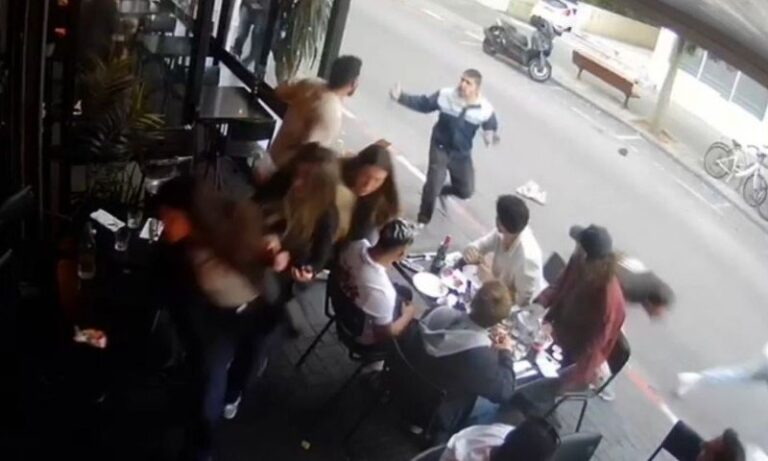 On the first day of Chol HaMoed, the Five Towns/Far Rockaway community was privileged to hear a shiur from Rav Mordechai Stern, the newly installed Rabbi of the W Shul in Lawrence, New York. Rabbi Stern is the son-in-law of Rav Moshe Brown Shlita, the son of Rabbi Stern Shlita from Mesivta Chaim Shlomo (Darchei Torah’s high School) and is an alumnus of BMG. The Shiur was delivered to a crowd of hundreds in the Agudas Yisroel Synagogue of Long Island. What appears below is a brief sketch of his words.
On the first day of Chol HaMoed, the Five Towns/Far Rockaway community was privileged to hear a shiur from Rav Mordechai Stern, the newly installed Rabbi of the W Shul in Lawrence, New York. Rabbi Stern is the son-in-law of Rav Moshe Brown Shlita, the son of Rabbi Stern Shlita from Mesivta Chaim Shlomo (Darchei Torah’s high School) and is an alumnus of BMG. The Shiur was delivered to a crowd of hundreds in the Agudas Yisroel Synagogue of Long Island. What appears below is a brief sketch of his words.
The Shiur was on the subject matter of Shimur, guarding, in regard to Matzos. Rabbi Stern posed a number of questions and contradictions in the sugya and answered the problems with the use of a principle presented by Rav Chaim Soloveitchik zt”l in Chiddushei Rav Chaim HaLevi on the Rambam. After the shiur, Rabbi Stern provided an inspiring explanation of the dual nature of Matzah – how it is both simultaneously an indication of the bread of our affliction and the bread signifying our freedom.
Rav Stern began with Rava’s position in the Gemorah in Psachim 40a that it is a Mitzvah to do lesisa – soaking and washing of the grain that will be used for the Matzos Mitzvah on Pesach night. He says this because of the drasha on the verse, “u’shmartem es hamatzos – and you shall guard the Matzos.” Rava seems to understand this verse as referring to the Matzos even before they become Matzos – this is the meaning of the term “M’ikara – from the beginning” in the Gemorah.
Rabbi Stern proceeded to list a number of difficulties: The first difficulty is an apparent contradiction in the words of the Ramban. In his comments on the Gemorah (Psachim 40a), the Ramban is unsure as to whether Rava’s requirement of shimur for the grains is an absolute requirement or is the Matzah still permitted even if this requirement was not met. The Ramban leaves the matter unresolved.
Yet, elsewhere in his Milchemes Hashem commentary in Perek Kol Shaah, Regarding Matzah made with fruit juice, the Ramban asks why it is necessary for the Gemorah to say that Matzah made from fruit juice is invalid because it is Matzah Ashira and cannot become Chometz – it should be invalid because it is not possible to do a shmirah on it before-hand! It must be then that watching it after it is made that it not become Chometz does not constitute a valid action of shimur – guarding the Matzah. Why then is he unsure of this in his comments on the Gemorah?
Rabbi Stern pointed to another difficulty raised by the Chazon Ish (Psachim 20:2). Unlike the Rambam who holds that one fulfills the Mitzvah of Matzah when it is made with Mei Peiros, the Ramban holds that one may not – because it cannot become Chometz. Chazon Ish points to a difference between the case of Matzah made from fruit juice and Matzah made from Revucha, a type that cannot become Chometz. The Ramban had compared the two.
A third question Rabbi Stern posed deals with the wording of the Shulchan Aruch (OC 460:1), who writes that the kneading and the baking cannot be done by a gentile or child. The TaZ infers that for the reaping and grinding, it is sufficient if a Jew merely observes it. The Shulchan Aruch in 453 writes of the requirement that the Matzah be done lishma. The Bach, on the other hand, writes that all aspects require shimur – guarding.
Rav Chaim Soloveitchik (Hilchos Chometz uMatzah writes that there are two components in the law of guarding the Matzah. The first component, an obligation on the individual, is the main guarding – to ensure that it not become Chometz which is the essence of the Mitzvah of Shmirah. The second component lies in the item of the Matzah itself – that it be an item that is watched and guarded for the purpose of Matzah. It is for this reason that if it was watched or guarded for another purpose, the watching is ineffective.
A critical difference between these two components is when the guarding is being done by a minor or a gentile but the adult Jew is overseeing him. This would fulfill the requirement of the first component, but not the second component since the item itself is not halachically considered watched or guarded.
With this principle, Rabbi Stern resolved all of the questions.
He explained that the act of guarding the Matzah must be established within the framework of the very item of the Matzah. True all this emanates from one verse. However, when one wishes to do an act of guarding before the Matzah dough exists an adult Jew watching is sufficient. After the kneading, however, where the act of guarding must be introduced within the framework of the item of the Matzah, then the adult Jew watching is no longer sufficient.
This will resolve the two questions on the Ramban. Matzos from fruit juice do not have the component of veshamartem es haMatzos. This would resolve the question on the Ramban that the Chazon Ish asks. Also the venishmartem component within the Matzah begins only at the point of kneading – not beforehand. This would also explain the words of the TaZ as well.
The yom tov is called, “chag hamatzos – the holiday of Matzos.” The name of something establishes its essence. Chag hamatzos is the essence that is zman cherisainu. What is the connection between matzos and chairus? True, He took them out bechipazon. But many meforshim ask: We find a different concept in Matzah – poor man’s bread.. How is the “lechem oni” reflective of cheirus? Some say that the matzah of lechem oni is different than the other matzah.
The pasuk, however, lechem oni ki bechipazon, indicates that it is all one – the lechem oni is because of the chipazon. The matzah of ha lachma anya is the chipazon. How do we understand this?
These are not two separate concept. They didn’t go out though a revolution or by virtue of a charismatic leader – no it was “lo hispik batzeikam lehachmitz – the dough did not have time to rise.” At the time of the formation of our nation – we became an ummah because we have nothing. The grandeur of Egypt fell because of the majesty of a nation who had nothing but G-d Himself. What is our national identity? A people who have nothing except for the rebono shel olam itself!! Through this, our national soul and body sanctify – that is the true freedom– a ben chorim is someone free of external sources. There is no davar mibachutz – if we realize that we have nothing and our lives are here solely to bring Kavod to Hashem.
The author can be reached at [email protected]











One Response
WELL if its only a din on the man but not in the framework of the matzoh, how can it b eposul all seven ?? after all besides teh seder nights it ok to eat potatoes, so if he opts to eat matzoh he shouldn’t be penalized